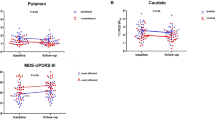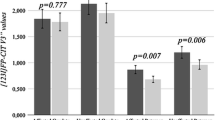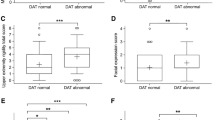Abstract
Purpose
Parkinson’s disease (PD) can manifest with a tremor-dominant or a non-tremor (akinetic-rigid) phenotype. Although the tremor-dominant subtype may show a better prognosis, there is limited information on the phenotypic differences regarding the level of striatal dopamine transmission. The present study investigated striatal dopamine transporter (DAT) binding characteristics in a large sample of patients with and without tremor.
Methods
[123I]FP-CIT SPECT scans of 231 patients with a clinical diagnosis of PD and abnormal FP-CIT binding (157 with tremor, 74 without tremor) and 230 control patients with normal FP-CIT binding (148 with tremor, 82 without tremor) were analysed using an automated region-of-interest analysis of the scans (BRASS). Specific striatal binding ratios were compared between phenotypes and groups using age, sex, and symptom duration, predominant side of symptoms, dopaminergic medications and scanner as covariates.
Results
Patients with PD had 28.1 – 65.0 % lower binding in all striatal regions compared to controls (p < 0.001). The mean FP-CIT caudate nucleus uptake and the left caudate nucleus uptake were higher in PD patients with tremor than in PD patients without tremor (mean 9.0 % higher, left 10.5 % higher; p < 0.05), whereas there were no differences between tremor and non-tremor control patients. No significant effects of tremor on DAT binding were observed in the anterior or posterior putamen.
Conclusion
The motor phenotype is associated with the extent of caudate dopamine terminal loss in PD, as dopamine function is relatively more preserved in tremor patients. Symptom type is related to caudate dopamine function only in association with Parkinsonian dopaminergic degeneration, not in intact dopamine systems in patients with non-PD tremor.


Similar content being viewed by others
References
Abdo WF, van de Warrenburg BP, Burn DJ, Quinn NP, Bloem BR. The clinical approach to movement disorders. Nat Rev Neurol. 2010;6:29–37. doi:10.1038/nrneurol.2009.196.
Hallett M. Parkinson’s disease tremor: pathophysiology. Parkinsonism Relat Disord. 2012;18 Suppl 1:S85–6. doi:10.1016/S1353-8020(11)70027-X.
Helmich RC, Hallett M, Deuschl G, Toni I, Bloem BR. Cerebral causes and consequences of Parkinsonian resting tremor: a tale of two circuits? Brain. 2012;135:3206–26. doi:10.1093/brain/aws023.
Clarimón J, Pagonabarraga J, Paisán-Ruíz C, Campolongo A, Pascual-Sedano B, Martí-Massó JF, et al. Tremor dominant Parkinsonism: clinical description and LRRK2 mutation screening. Mov Disord. 2008;23:518–23. doi:10.1002/mds.21771.
Jankovic J, McDermott M, Carter J, Gauthier S, Goetz C, Golbe L, et al. Variable expression of Parkinson’s disease: a base-line analysis of the DATATOP cohort. The Parkinson Study Group. Neurology. 1990;40:1529–34.
Zetusky WJ, Jankovic J, Pirozzolo FJ. The heterogeneity of Parkinson’s disease: clinical and prognostic implications. Neurology. 1985;35:522–6.
Williams-Gray CH, Foltynie T, Brayne CE, Robbins TW, Barker RA. Evolution of cognitive dysfunction in an incident Parkinson’s disease cohort. Brain. 2007;130:1787–98. doi:10.1093/brain/awm111.
Selikhova M, Kempster PA, Revesz T, Holton JL, Lees AJ. Neuropathological findings in benign tremulous Parkinsonism. Mov Disord. 2013;28:145–52. doi:10.1002/mds.25220.
Prodoehl J, Planetta PJ, Kurani AS, Comella CL, Corcos DM, Vaillancourt DE. Differences in brain activation between tremor- and nontremor-dominant Parkinson diseases. JAMA Neurol. 2013;70:100–6. doi:10.1001/jamaneurol.2013.582.
Rosenberg-Katz K, Herman T, Jacob Y, Giladi N, Hendler T, Hausdorff JM. Gray matter atrophy distinguishes between Parkinson disease motor subtypes. Neurology. 2013;80:1476–84. doi:10.1212/WNL.0b013e31828cfaa4.
Zhang YH, Tang BS, Song CY, Xu Q, Lou MX, Liu ZH, et al. The relationship between the phenotype of Parkinson’s disease and levodopa-induced dyskinesia. Neurosci Lett. 2013;556:109–12. doi:10.1016/j.neulet.2013.10.018.
Kang JH, Irwin DJ, Chen-Plotkin AS, Siderowf A, Caspell C, Coffey CS, et al. Association of cerebrospinal fluid β-amyloid 1-42, T-tau, P-tau181, and α-synuclein levels with clinical features of drug-naive patients with early Parkinson disease. JAMA Neurol. 2013;70:1277–87. doi:10.1001/jamaneurol.2013.3861.
Spiegel J, Hellwig D, Samnick S, Jost W, Möllers MO, Fassbender K, et al. Striatal FP-CIT uptake differs in the subtypes of early Parkinson’s disease. J Neural Transm. 2007;114:331–5. doi:10.1007/s00702-006-0518-2.
Helmich RC, Janssen MJ, Oyen WJ, Bloem BR, Toni I. Pallidal dysfunction drives a cerebellothalamic circuit into Parkinson tremor. Ann Neurol. 2011;69:269–81. doi:10.1002/ana.22361.
Schillaci O, Chiaravalloti A, Pierantozzi M, Di Pietro B, Koch G, Bruni C, et al. Different patterns of nigrostriatal degeneration in tremor type versus the akinetic-rigid and mixed types of Parkinson’s disease at the early stages: molecular imaging with 123I-FP-CIT SPECT. Int J Mol Med. 2011;28:881–6. doi:10.3892/ijmm.2011.764.
Rossi C, Frosini D, Volterrani D, De Feo P, Unti E, Nicoletti V, et al. Differences in nigro-striatal impairment in clinical variants of early Parkinson’s disease: evidence from a FP-CIT SPECT study. Eur J Neurol. 2010;17:626–30. doi:10.1111/j.1468-1331.2009.02898.x.
Isaias IU, Benti R, Cilia R, Canesi M, Marotta G, Gerundini P, et al. [123I]FP-CIT striatal binding in early Parkinson’s disease patients with tremor vs. akinetic-rigid onset. Neuroreport. 2007;18:1499–502.
Song IU, Chung YA, Oh JK, Chung SW. An FP-CIT PET comparison of the difference in dopaminergic neuronal loss in subtypes of early Parkinson’s disease. Acta Radiol. 2014:55:366–71. doi:10.1177/0284185113498075.
Eggers C, Kahraman D, Fink GR, Schmidt M, Timmermann L. Akinetic-rigid and tremor-dominant Parkinson’s disease patients show different patterns of FP-CIT single photon emission computed tomography. Mov Disord. 2011;26:416–23. doi:10.1002/mds.23468.
Varrone A, Dickson JC, Tossici-Bolt L, Sera T, Asenbaum S, Booij J, et al. European multicentre database of healthy controls for [(123)I]FP-CIT SPECT (ENC-DAT): age-related effects, gender differences and evaluation of different methods of analysis. Eur J Nucl Med Mol Imaging. 2013;40:213–27. doi:10.1007/s00259-012-2276-8.
Pirker W. Correlation of dopamine transporter imaging with Parkinsonian motor handicap: how close is it? Mov Disord. 2003;18 Suppl 7:S43–51. doi:10.1002/mds.10579.
Fishman PS. Paradoxical aspects of Parkinsonian tremor. Mov Disord. 2008;23:168–73. doi:10.1002/mds.21736.
Mure H, Hirano S, Tang CC, Isaias IU, Antonini A, Ma Y, et al. Parkinson’s disease tremor-related metabolic network: characterization, progression, and treatment effects. Neuroimage. 2011;54:1244–53. doi:10.1016/j.neuroimage.2010.09.028.
Hallett M. Tremor: pathophysiology. Parkinsonism Relat Disord. 2014;20 Suppl 1:S118–22. doi:10.1016/S1353-8020(13)70029-4.
Burn DJ, Rowan EN, Allan LM, Molloy S, O’Brien JT, McKeith IG. Motor subtype and cognitive decline in Parkinson’s disease, Parkinson’s disease with dementia, and dementia with Lewy bodies. J Neurol Neurosurg Psychiatry. 2006;77:585–9. doi:10.1136/jnnp.2005.081711.
Alves G, Larsen JP, Emre M, Wentzel-Larsen T, Aarsland D. Changes in motor subtype and risk for incident dementia in Parkinson’s disease. Mov Disord. 2006;21:1123–30. doi:10.1002/mds.20897.
Burn DJ, Landau S, Hindle JV, Samuel M, Wilson KC, Hurt CS, et al. Parkinson’s disease motor subtypes and mood. Mov Disord. 2012;27:379–86. doi:10.1002/mds.24041.
Kaasinen V, Rinne JO. Functional imaging studies of dopamine system and cognition in normal aging and Parkinson’s disease. Neurosci Biobehav Rev. 2002;26:785–93.
Di Giuda D, Camardese G, Bentivoglio AR, Cocciolillo F, Guidubaldi A, Pucci L, et al. Dopaminergic dysfunction and psychiatric symptoms in movement disorders: a 123I-FP-CIT SPECT study. Eur J Nucl Med Mol Imaging. 2012;39:1937–48. doi:10.1007/s00259-012-2232-7.
Korchounov A, Schipper HI, Preobrazhenskaya IS, Kessler KR, Yakhno NN. Differences in age at onset and familial aggregation between clinical types of idiopathic Parkinson’s disease. Mov Disord. 2004;19:1059–64. doi:10.1002/mds.20061.
Marras C, Lang A. Parkinson’s disease subtypes: lost in translation? J Neurol Neurosurg Psychiatry. 2013;84:409–15. doi:10.1136/jnnp-2012-303455.
Stebbins GT, Goetz CG, Burn DJ, Jankovic J, Khoo TK, Tilley BC. How to identify tremor dominant and postural instability/gait difficulty groups with the movement disorder society unified Parkinson’s disease rating scale: comparison with the unified Parkinson’s disease rating scale. Mov Disord. 2013;28:668–70. doi:10.1002/mds.25383.
Liscic RM, Srulijes K, Gröger A, Maetzler W, Berg D. Differentiation of progressive supranuclear palsy: clinical, imaging and laboratory tools. Acta Neurol Scand. 2013;127:362–70. doi:10.1111/ane.12067.
Oh M, Kim JS, Kim JY, Shin KH, Park SH, Kim HO, et al. Subregional patterns of preferential striatal dopamine transporter loss differ in Parkinson disease, progressive supranuclear palsy, and multiple-system atrophy. J Nucl Med. 2012;53:399–406. doi:10.2967/jnumed.111.095224.
Savica R, Grossardt BR, Bower JH, Ahlskog JE, Rocca WA. Incidence and pathology of synucleinopathies and tauopathies related to Parkinsonism. JAMA Neurol. 2013;70:859–66. doi:10.1001/jamaneurol.2013.114.
Kaindlstorfer C, Granata R, Wenning GK. Tremor in multiple system atrophy – a review. Tremor Other Hyperkinet Mov (N Y). 2013;3:http://tremorjournal.org/article/view/165.
Acknowledgments
The contribution of the staff of the Department of Nuclear Medicine, Turku University Hospital, is gratefully acknowledged. This study was financially supported by the Academy of Finland (decision # 256836) and Turku University Hospital (ERVA funds).
Conflicts of interest
None.
Author information
Authors and Affiliations
Corresponding author
Rights and permissions
About this article
Cite this article
Kaasinen, V., Kinos, M., Joutsa, J. et al. Differences in striatal dopamine transporter density between tremor dominant and non-tremor Parkinson’s disease. Eur J Nucl Med Mol Imaging 41, 1931–1937 (2014). https://doi.org/10.1007/s00259-014-2796-5
Received:
Accepted:
Published:
Issue Date:
DOI: https://doi.org/10.1007/s00259-014-2796-5




